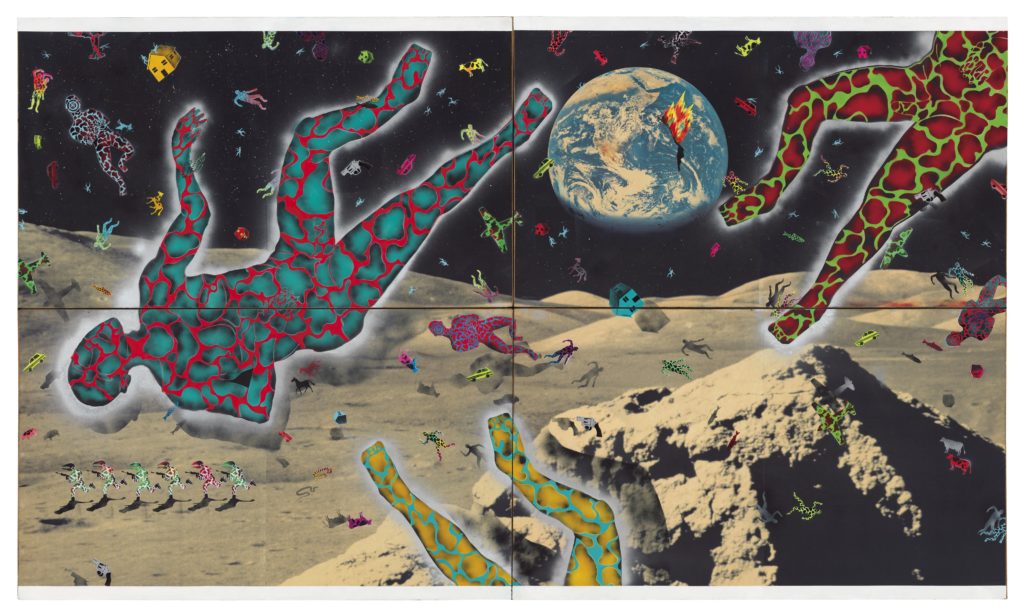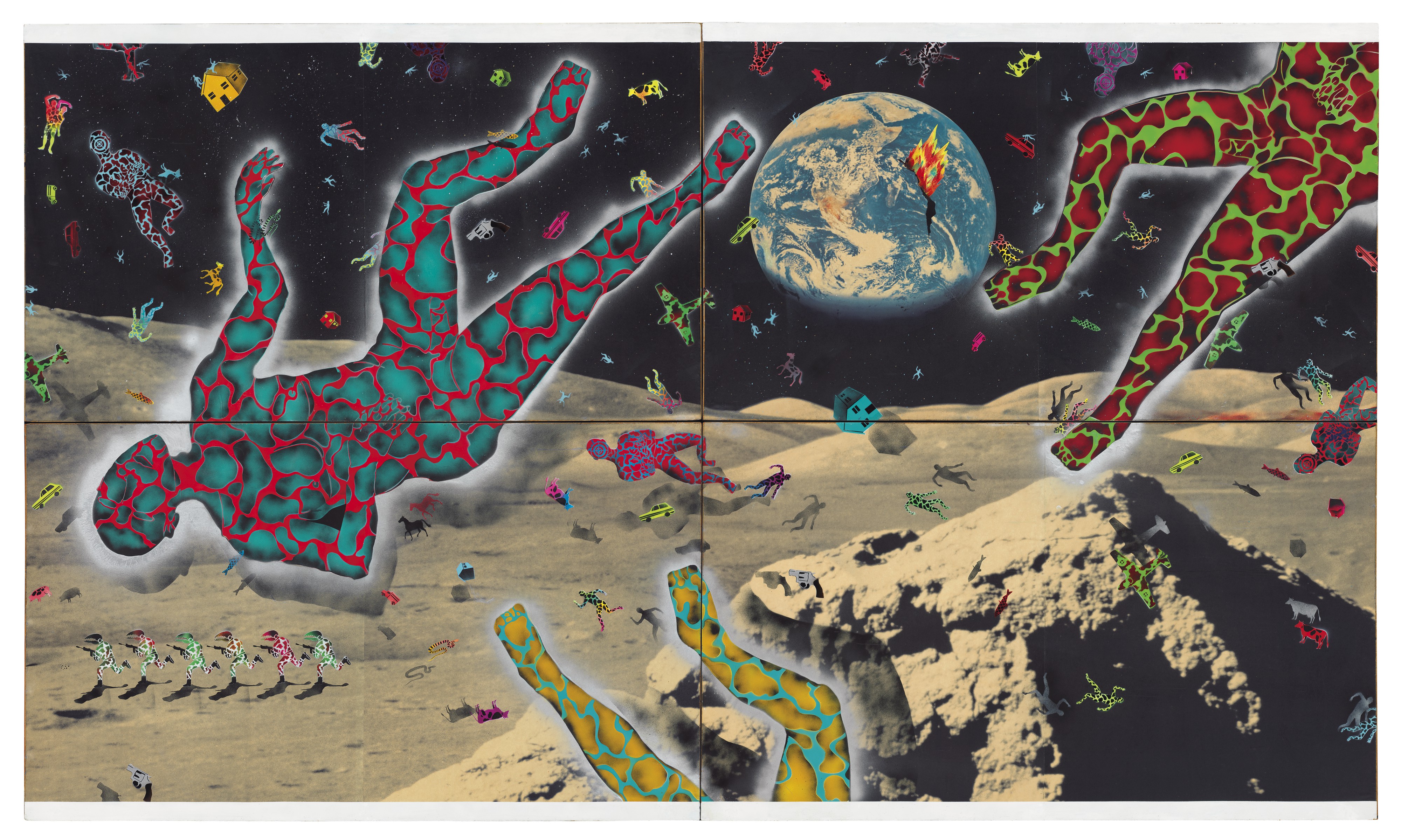[ad_1]

David Wojnarowicz, Science Lesson, 1982–83.
COURTESY CHRISTIE’S
Ten years ago, when auction house veteran Amy Cappellazzo was co-head of the postwar and contemporary department at Christie’s, she told the journalist Sarah Thornton, “We lay out a sale commercially. . . . The first ten lots all have to go well. We tend to put things in there that will soar past the high estimate—young, hot, contemporary things that get the room going. At around Lot twelve or thirteen, we’d better be entering a serious price point.”
That wisdom seemingly endures. Cappellazzo, and the art advisory she founded a few years ago, is now at Sotheby’s, where the sixth lot in the house’s evening sale of contemporary art on May 18 is a 2013 painting by Avery Singer, an artist who turned 30 last year. It’s the first time a work by Singer has been in an evening sale—and, in fact, it will be only the third time her work has been at auction. Sotheby’s has a smaller 2016 painting by her in a day sale the day before its evening sale, estimated at $40,000 to $60,000, and a 2013 painting by her sold in a day sale at Sotheby’s London last fall for about $35,900 against a presale estimate of about $19,600–$26,000. The painting in the upcoming Sotheby’s evening sale, which was shown at Greene Naftali gallery in New York the year it was made and has already passed through two owners, is three times the size of those two works, and is estimated at $80,000 to $120,000.
Cappellazzo’s alma mater also has a surprise first-timer at an evening sale among the first few lots: the first lot in Christie’s contemporary sale on May 17 in Rockefeller Center in Midtown Manhattan is not a closely watched young talent, but instead the highly political New York artist David Wojnarowicz, who passed away in 1992, at 37. Science Lesson (1982–83), a large-scale piece of acrylic, spray paint, and photographs mounted on four Masonite panels is estimated to sell for $400,000 to $600,000.
“Now is the moment to launch him onto an international platform,” said Andy Massad, Christie’s deputy chairman of postwar and contemporary art department, said of Wojnarowicz, whose retrospective opens at the Whitney Museum in New York in July. “There’s a lot of education that needs to be done out there, because honestly he’s seen more as a very intense cult figure. He’s always been collected by [Eli] Broad and [Emily and Jerry] Spiegel, serious collectors. But he’s had this meteoric career and there’s not a lot of work out there that trades regularly.”
Wojnarowicz, who is almost as well known for his activist work around the AIDS crisis and gay rights as he is for his art, has sprung back into the art world’s collective mind in a political climate that parallels the tumult and disillusionment of his era. “I feel that I’m caught in the invisible arms of government in a country slowly dying beyond our grasp,” Wojnarowicz writes in his 1991 memoir-cum-essay collection, Close to the Knives. He would die of AIDS-related causes the next year.
The artist’s current auction record, for the 1987–89 piece Mexico Crucifix, is $312,500, set at a Christie’s day sale of contemporary art last November. The presale estimate that day was $80,000–$120,000. In fact, Wojnarowicz’s three most-highly-valued pieces at auction have at least doubled their presale estimates. Earlier this year, Untitled (Buffaloes), 1988–89, sold for $125,000 at Bonhams New York, a huge jump from its $20,000–$30,000 estimate. Back in 2012, History Keeps Me Awake At Night (1954–1992) brought in $122,500 against a $50,000–$70,000 estimate in a Christie’s day sale.
“This is really early in his career. It’s sort of the foundation of his visual language,” Massad said of Science Lesson. “It was originally shown at a gallery called Civilian Warfare, which is a really early gallery in the East Village. It was a storefront, guerrilla sort of gallery, and it was the only piece in the show when it was first seen there.”
The piece, which was in the 1985 Whitney Biennial, exemplifies the artist’s political commitments. Painted bodies burst into space from a fiery crack in the earth’s surface, mingling with farmhouses, weaponry, and livestock suspended over the floor of the moon. Wojnarowicz is known for incorporating rich symbology into his work having to do with feelings of disenfranchisement, political rage, and tenacious resistance against the powers that be.
An evening sale outing, where the stakes are high, is not as risky for an estate as it is for a living artist, but New York dealer Wendy Olsoff, who has managed Wojnarowicz’s work through her P.P.O.W. Gallery since before he died, will be watching the sale closely.
“I feel really proud that the gallery was able to support David for 25 years,” she said, “and now he’s setting the tone for the auction at Christie’s. It’s a little bit nerve-wracking because you want it to do well, and you also think that now he’ll be a little out of our control because people might decide to resell if it goes really high. We’ve really only ever sold the work to serious collectors interested in his work or museums,” she said, adding, “We hope that David gets recognition also because of the time with Trump. More young people should see his work and read his biography and go to the Whitney show. It’s very relevant to what’s going on in our country.”
The artist was “before the contemporary world of commerce and business,” said David Kiehl, who is organizing the retrospective with David Breslin, a fellow curator at the Whitney. “I think Wojnarowicz is going to be a surprise for a lot of people, and they’re going to ask why they hadn’t thought of him before.”
Kiehl said that, though he admires Science Lesson, there are other pieces he’d rather see set the artist’s auction record, like a series of lithographs, titled Four Elements (1990). From Kiehl’s perspective, these pieces bring to light a lesser-known side of Wojnarowicz as an environmentalist and have new relevance in the age of fracking. (His selection also points to the vagaries of the art market: one edition failed to sell at Bonhams San Francisco just five years with an estimate of only $2,000 to $3,000.)
Kiehl, who has been working towards the retrospective for over a decade, attributed the renewed interest in Wojnarowicz to newfound appreciation for the artist’s writing. In Close to the Knives, he described looking at a newspaper headline about an unspecified Supreme Court ruling that deprived homosexuals of Constitutional rights. He writes, “I felt a sensation like seeing oneself from miles above the earth or looking at one’s reflection in a mirror through the wrong end of a telescope. Realizing that I have nothing left to lose in my actions I let my hands become weapons, my teeth become weapons, every bone & muscle & fiber & ounce of blood become weapons, & I feel prepared for the rest of my life.”
The genesis for the upcoming retrospective came two days after 9/11, as Kiehl was flipping through a Christie’s catalogue. “I saw one [of his pieces] and said, ‘Oh! That’s the guy who used to paint on the sidewalks,’ ” he said. “When I lived in TriBeCa, that’s where I remember these symbols painted on the sidewalks. So I went to look at it and I flipped out, and realized, This is David Wojnarowicz! I knew that once I started looking more into David’s work, that more needed to be done.”
[ad_2]
Source link

